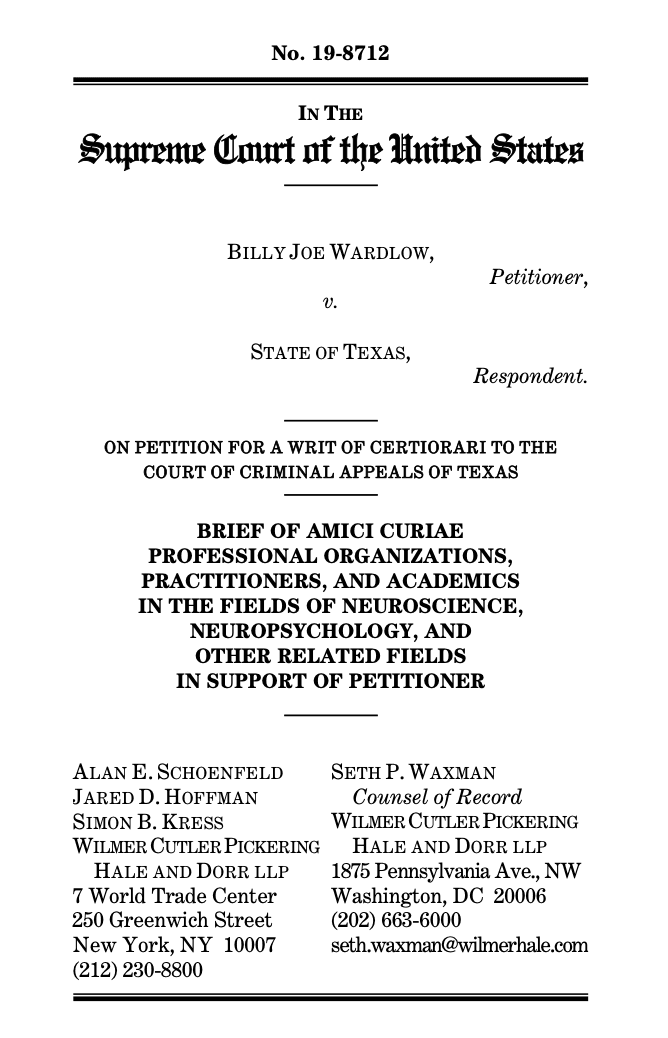
Summary of Argument
This case presents the question whether the Eighth Amendment permits a State to predicate the death penalty on a jury determination that an 18-year- old convicted of murder “will more likely than not commit criminal acts of violence in the future so as to constitute a continuing threat to society.” The great weight of scientific evidence—much of it developed over the past 15 years—shows clearly that reliable determinations about future dangerousness cannot be made with respect to violent offenders under 21 years of age. Because the Eighth Amendment prohibits the State from executing individuals based on unreliable or arbitrary determinations, see Johnson v. Mississippi, 486 U.S. 578, 584 (1988), no sentence of death consistent with the Constitution may be predicated on a prediction of an 18-year-old’s propensity for future dangerousness.
Over the last 15 years, this Court has issued three landmark decisions that significantly altered the treatment of young people in the criminal justice system. Miller v. Alabama, 567 U.S. 460 (2012); Graham v. Florida, 560 U.S. 48 (2010); Roper v. Simmons, 543 U.S. 551 (2005). In all three decisions, the Court looked to an established scientific consensus regarding adolescent development and considered the unique attributes of youth when applying constitutional protections to juvenile offenders. As a result, the Court’s “decisions rested not only on common sense—on what ‘any parent knows’—but on science and social science as well.” Miller, 567 U.S. at 471.
Over that same 15-year period, advancements in neuroscience and brain imaging research have revealed that the unique characteristics of youth this Court identified in Roper, Graham, and Miller—immaturity, susceptibility, and changeability—persist beyond age 18. It is now well-established that a human brain continues to undergo profound changes throughout adolescence and young adulthood—a period sometimes referred to as “emerging adulthood”—in the areas and systems that are regarded as most involved in impulse control, planning, and self-regulation. Brain imaging and other novel developments in neuroscience have made visible the differences between the developing brain and the adult brain as never before, effecting a paradigm shift in the way the behavior of emerging adults is understood in the scientific community. Well-established, peer-reviewed research, as well as our collective professional experience, demonstrate that it is scientifically impossible reliably to predict the future dangerousness of an offender who commits a crime while under the age of 21.
Billy Joe Wardlow was 18 years old when he killed Carl Cole in northeast Texas in 1993. He was convicted of capital murder and sentenced to death in 1995 based on the sole aggravating factor then available in the Texas death penalty statute—whether the defendant was likely to be dangerous in the future. But Texas’s death penalty statute under which Mr. Wardlow was sentenced to death turned on a determination that can- not be made in any objectively reliable manner for offenders who commit crimes under the age of 21. In Roper, this Court observed that “[i]t is difficult even for expert[s] ... to differentiate between the juvenile offender whose crime reflects unfortunate yet transient immaturity, and the rare juvenile offender whose crime reflects irreparable corruption.” 543 U.S. at 573. That was an understatement. It simply cannot be done with any technology or methodology available today to the scientific community, and it certainly could not be done in 1995 when Mr. Wardlow was sentenced to death.